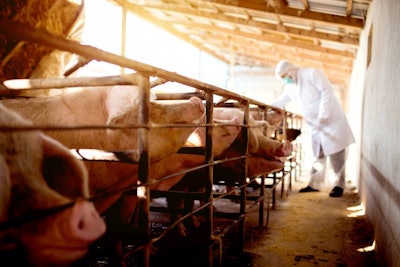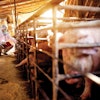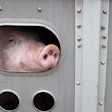
New cases have been reported in the wild boar of 5 European countries over the past week.
So far this year, Poland has registered eight outbreaks of African swine fever (ASF) in domestic pigs. That includes six outbreaks confirmed in the past week, while new cases have also occurred in backyard herds in Romania and Russia. One German state is taking additional measures to protect its wild and farmed populations from this devastating disease.
In Poland, six new outbreaks of ASF have been confirmed in domestic pigs over the past week, all affecting small herds. Each had between 12 and 149 animals — a total of 403 pigs.
Three of the outbreaks are designated primary outbreaks by the Poland’s chief veterinary office, while the others are secondary outbreaks, presumably with an epidemiological link to the respective primary.
Confirmed on June 19, the first of the latest outbreaks was in Lodz. This was soon followed by two secondary outbreaks in the same province. Located in central Poland, these are the first ASF outbreaks to have been recorded in this province. One subsequent outbreak linked to the initial one is in neighboring Greater Poland (Wielkopolskie). Within days, new primary outbreaks were confirmed — one in each of Lublin and Subcarpathia (Podkarpackie) in southeastern Poland.
Source of infection in the latest outbreaks is not identified. However, the virus has been detected in more than 1,780 wild boar in the country so far this year alone.
In 2020, there were 103 outbreaks of ASF in Polish pigs between the months of March and October. In mid-March of this year, the disease re-emerged at a large farm with 16,000 animals in the western province of Lubusz. Next cases were at another farm (3,373 pigs), this time in Greater Poland earlier in June.
New ASF cases among Romanian, Russian domestic pigs
In each of two regions of Russia’s Central federal district, new cases of ASF have been recorded in swine.
According to the official reports to the World Organization for Animal Health (OIE), these involved two backyard herds. At the end of May, a herd of 296 pigs was hit by the disease in Yaroslavl oblast. Of these, 148 animals died. All 13 of the pigs in a backyard herd in Vladimir oblast died of the disease this month.
Meanwhile, Romania continues its three-year battle to control ASF among its backyard pig sector across much of the country.
Latest official reports to the OIE outline a further 19 outbreaks of the disease confirmed since mid-June. Directly impacted were 206 pigs in the northwest, center and south of the country. Affected herds ranged from one to 53 animals.
German state resolves to extend ASF controls on eastern border
Last week, the team dealing with the response to the ASF crisis in the eastern state of Brandenburg resolved to adopt new measures to control the infection. This will involve the construction of a protective corridor along the state’s border with Poland, according to Schweine from the country’s pig industry association (ISN).
The team describes the ASF situation in Poland as “highly dynamic,” as the virus has been spreading in wild boar throughout this year so far. With a single border fence, there is no sign of the cases easing in the short term. As bilateral talks between the two national governments on additional measures have not yet reached agreement, the Brandenburg state government is to construct a second fence. To be built 500 meters from the existing border fence, it is hoped to provide a barrier area that can be kept free of wild boar.
This month, all of Germany’s federal states agreed to provide financial support to the two states so far affected by ASF in their wild boar populations — Brandenburg and Saxony.
As of June 25, the disease notification system of Germany’s veterinary agency put the number of confirmed ASF cases among wild boar in Brandenburg and neighboring Saxony so far at 1,389.
ASF situation among European wild boar
Germany’s total cases of ASF in wild boar now stands at 1,423 animals, based on information from the respective administrations of the two states affected so far.
With 1,156 confirmed cases since September 2020 (as of June 28), the eastern German state of Brandenburg continues to bear the brunt of the nation’s ASF infections. Positive cases have been detected in five districts, according to the agriculture ministry. Compared with the situation on June 17, this is an increase of 94 cases. Worst affected is Oder-Spree with 611 of the total cases, and the largest rise in cases — 52 over this period — was in Frankfurt (Oder).
Neighboring Saxony is the only other German state where ASF-positive cases have been detected among wild boar. By June 22, its total had reached 267 cases. This is an increase of 14 since June 14, reports the agriculture ministry. All infected cases so far have been found in the district of Görlitz.
As well as Germany, four other European countries have registered with the OIE new cases of ASF in wild boar over the past week.
These were Hungary (45 new cases), Romania (16), Russia (12 in the oblasts of Saratov and Yaroslavl), and Latvia (two).
Meanwhile, Ukraine’s animal health agency has declared to the OIE that the ASF situation in Kiev oblast has been “resolved.” A wild boar found in a forest in this area in April has tested positive for the ASF virus. This was the only case since February.
Falling pig numbers in Germany partly blamed on ASF
Although ASF was first confirmed in the country’s wild boar population in September 2020, Germany’s domestic pig population so far remains free of the infection.
However, Schweine attributes the latest year-on-year fall of 840,000 or 3.3% in the nation’s pig population partly to ASF.
Combined with the market impacts of the coronavirus (COVID-19) pandemic, ASF has caused pork market prices to fall significantly in Germany, according to this source. Furthermore, around 700 of the country’s pig producers have given up their businesses over the past year.
View our continuing coverage of the global African swine fever situation.










